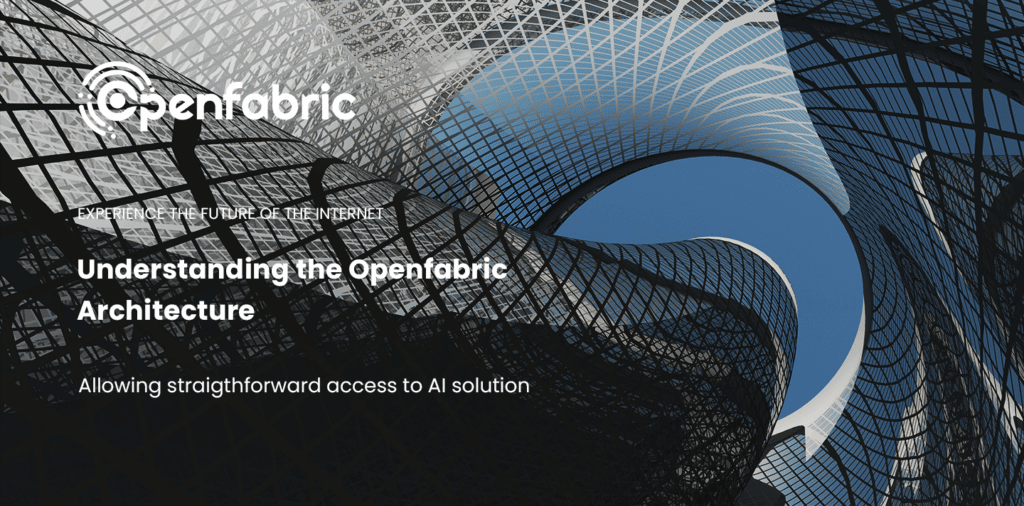
August 9, 2022 4 minutes read
Understanding the Openfabric Architecture

Openfabric’s architecture is the manifestation of the project’s objective of “Creating the most inclusive and coherent community and marketplace for AI resources, developers and companies”.
At the core of this architecture lies the blockchain and distributed ledger technology. Today, we briefly examine how the architecture constitutes the Openfabric platform.
Need for an AI platform
Before moving on to the architecture let us understand why there was a need for such an AI platform and how this resulted in the development of the Openfabric architecture. Back in 2019, the Openfabric concept was formulated after a careful study of the existing AI solutions. It was discovered that no such platform existed that could provide a consumers with a low barrier to entry in the space. All the existing solutions were either too difficult to use or failed to address the pain points of their users. To fill this market gap, Openfabric brought forward a solution that eventually became the go-to AI platform for all. This was achieved by carefully designing an architecture that not only enabled the creation of a robust platform but also kept user experience as a top priority.
Below, we take a look at how this architecture functions.
Overview of the architecture
The components that make up the Openfabric platform include the following:
1. Distributed Ledger Technology (DLT)
The DLT layer can be rightfully termed as the communication backbone of the whole system. It ensures system replication, decentralization, and communication. An added advantage of using blockchain is that features like trust, security, and transparency are inherited with the blockchain.
2. The Openfabric Network
The Openfabric network consists of services such as the Registry AI and data, Ontology, Execution, Warranty and Staking, Reputation and Rating, and Storage. A trusted execution environment connects with the stakeholders of the system.
3. The Openfabric Platform
Next comes the Openfabric platform. It consists of the Openfabric Store, the Openfabric Toolkit, the Openfabric SDK and the Openfabric Daemon.
4. The Stakeholders
Lastly, we have the Openfabric stakeholders, including service consumers, AI innovators, data providers, and infrastructure providers. All of these stakeholders work together to build turnkey AI solutions that are accessible to all.
Ontology Model
Openfabric utilizes a protocol composed of interoperable ontology models that represent the input and output of the AI agents. Although each organization has its semantics, context, and perception of the data, this protocol will act as a translator/abstractor fostering internal and external collaborations. The model proposes a layered architecture in which each layer is composed of machine-readable semantic data structures that provide context on a particular dimension of the ontology concepts. The most important aspect of this approach is that data structures can be used, deployed, and updated in a decentralized manner.
The core layers are designed to store machine-targeted semantic information. The optional layers provide human-readable information in the communication between agents but are compelling in cases that involve human-computer interactions.
From a high-level perspective, the architecture is composed of the following layers:
- Structural layer – the formal specification of the ontology in its purest form, composed of concepts, properties, and relations.
- Connection layer – contains information about the location of concepts from external ontologies and mappings between multiple versions of the same ontology.
- Encoding layer – specifies the used encoding format, like UTF-8, ISO, or any other chosen format.
- Defaults layer – used to define the fallback values for specific properties.
- Validation layer – used to add formal validation rules for schema properties.
- Restriction layer – contains a set of contextual restrictions between schema properties.
- Naming layer – tags schema properties classes and relations in a human-readable format.
- Instruction layer – includes guidance information on how the user should provide the input data.
- Versioning layer – contains community proposals about schema structure changes and future evolution.
- Template layer – used for the contextual fragmentation of the schema.
Significance of the Architecture
The whole Openfabric architecture is carefully planned out and structured in such a way that offers the best possible output to all of the stakeholders of the system. This architecture results in a platform that makes the use of AI and blockchain technology much easier for the users. Even users with little or no technical know-how can make use of the platform and develop apps based on artificial intelligence.
It also helps in addressing some of the key issues faced by AI technology in the current era and aids in the collaboration between AI innovators, data providers, businesses, and infrastructure providers to facilitate the creation and use of new intelligent algorithms and services.
Learn More About the Architecture
The Openfabric whitepaper is a complete detailed resource that offers in-depth knowledge about the working of the Openfabric architecture as well as technical details about the platform. Readers seeking to learn more about the platform can easily access it on our website. For the latest updates regarding the platform, users can also visit our social media accounts on Twitter, Telegram, Linkedin, Facebook, and Youtube.

